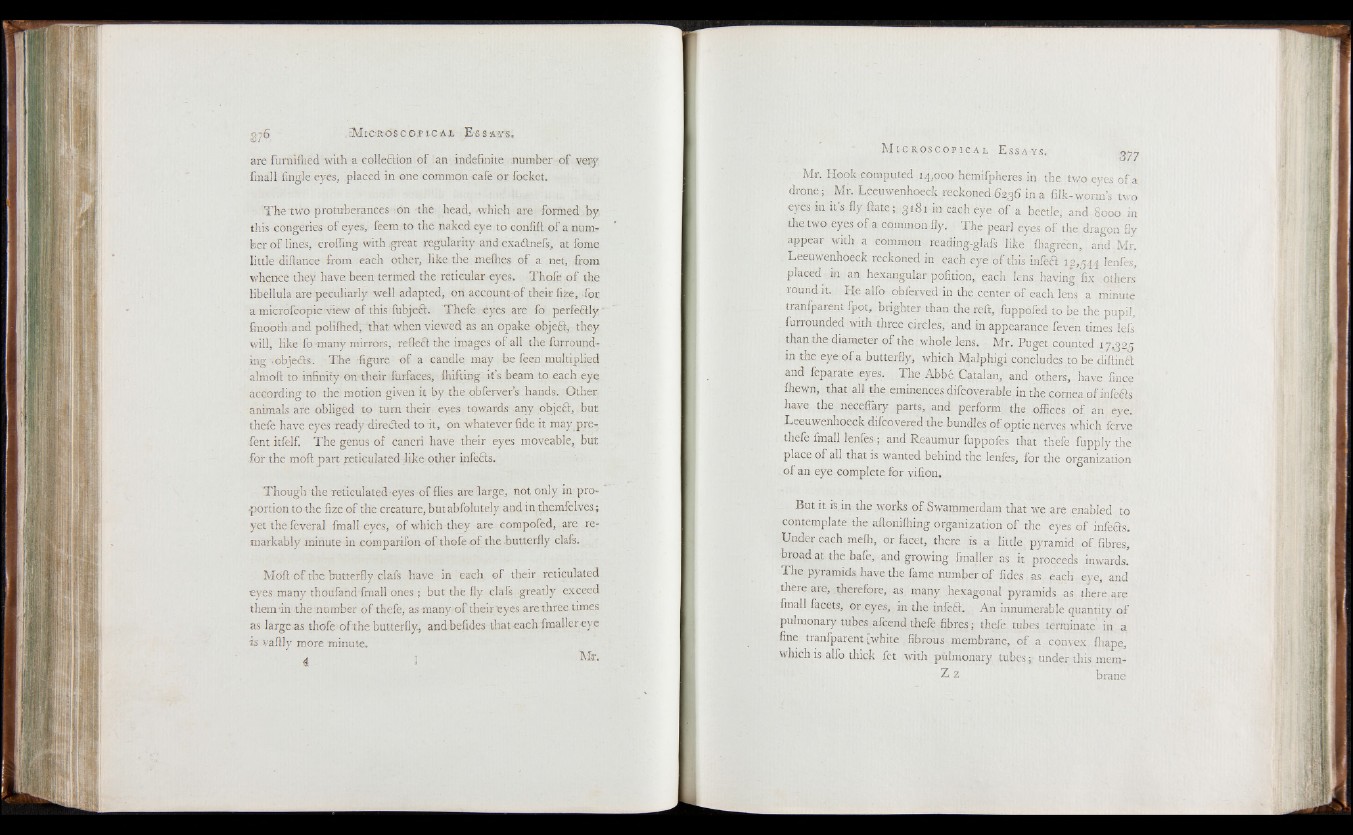
are furnifhed with a collection o f an indefinite number of very
final 1 Angle eyes, placed in one common-cafe or focket.
The two protuberances on the head, -which are formed by
this congeries of eyes, feem to the naked eye to eonfift of a number
of lines, crofting with -great regularity-and exadtnefs, at feme
little dillance from each other, like the mefhes o f a net, from
whence they have been termed the reticular-eyes. Thofe o f the
libellula are peculiarly well adapted, on aecount-of their fize, for
a microfcopic view of this fubjeft. Thefe eyes are fo perfectly
fmoot-h and polifhed, that when viewed as an opake object, they
will, like fo-many mirrors, refleft the images of all the furround-
ing -objekts. The -figure -of a candle may be feen multiplied
almoft to infinity on-their furfaces, Ihifting it’s beam to each eye
according to the motion given it by the obferver’s hands. Other
animals are obliged to turn their eyes towards -any object, but
thefe have eyes ready directed to it, on whatever fide it may pre-
fent itfelf. The genus of cancri have their eyes moveable, but
for the moil part reticulated like other infefts.
Though the reticulated eyes -of flies are large, not only in proportion
to the fize o f the creature, butabfolutely and inthemfelves;
yet thefeveral fmall eyes, o f which they are compofed, are remarkably
minute in .compaiifon of thofe-of the butterfly clafs.
Molt o f the butterfly -clafs have in each o f their reticulated
eyes many thoufand fmall ones ; but the fly clafs greatly exceed
them in the number of thefe, as many o f their eyes are three times
as large-as thofe o f the butterfly., and belides that each fmal-ler eye
is vaftly more minute.
Mr. Hook computed 14,000 hemifpheres in the two eyes of a
drone; Mr. Leeuwenhoeck reckoned 6236 in a filk-worm’s two
eyes in it’s fly flate; 3181 in each eye of a beetle, and 8000 in
the two eyes o f a common fly. The pearl eyes o f the dragon fly
appear with a common reading-glafs like fhagreen, and Mr.
Leeuwenhoeck reckoned in each eye o f this infeft 12,544 lenfes,
placed in an hexangular pofition, each lens having fix others
round it. He alfo obferved in the center of each lens a minute
tranfparent fpot, brighter than the reft, fuppôfed to be the pupil,
furrounded with three circles, and in appearance feven times lefs
than the diameter o f the whole lens. Mr. Puget counted 17,325
in the eye of a butterfly, which Malphigi concludes to be diftinft
and feparate eyes. The.Abbé Catalan, and others, have fince
fhewn, that all the eminences difcoverable in the cornea of infects
have the neceflary parts, and perform the offices o f an eye.
Leeuwenhoeck difcovered the bundles o f optic nerves which ferve
thefe fmall lenfes ; and Reaumur fuppofes that thefe fupply the
place o f all that is wanted behind the lenfes, for the organization
o f an eye complete for vifion.
But it is in the works of Swammerdam that we are enabled to
contemplate the aftonifhing organization o f the eyes of infefis.
Under each mefli, or facet, there is a little pyramid o f fibres,
broad at the bafe, and growing fmaller as it proceeds inwards.
The pyramids have the fame number o f fides as each eye, and
there are, therefore, as many hexagonal pyramids as there are
fmall facets, or eyes, in the infeft. An innumerable quantity o f
pulmonary tubes afcend thefe fibres ; thefe tubes terminate in a
fine tranfparent |,white fibrous membrane, o f a convex fhape,
which is alfo thick fet with pulmonary tubes ; under this mem-
Z 2 brane